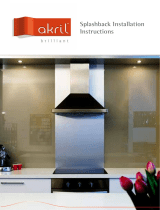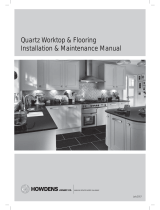
Glass Effect Acrylic Backboard
Installation
ASBLEAF01
HD416081
Avoid any direct contact with any source of heat in excess of 100°c and avoid impact and scuffs with sharp or heavy objects to reduce
the risk of damage.
Basic stains
Wash with mild soap or detergent, using plenty of warm water. Do not use an abrasive cleaner. Dry with a soft cloth or chamois. Grease,
oil or tar can be removed with Methylated spirits or Isopropyl alcohol. Solvent residue should be removed by washing immediately.
Do not use: Scouring compounds, steel wool, harsh scrubbing brushes, chloroform acetone, benzene, toluene, xylene,
dichloromethane, amyl acetate, glacial acetate acid, butyl alcohol, butyl acetate, cellusolve, cresols / phenols, Ethyl acetate,
chlorinated solvents, halogenated solvents, methyl alcohol, sulphuric acid, dilute acids, MEK methyl ethyl ketone (PVC pipe glue).
Surfaces that have accidentally been exposed to these chemicals should be flushed promptly with water, using appropriate measures
to avoid injury.
Repairing very fine scratches
Fine scratches can be buffed out with a polishing compound (such as Mirka M35 cutting compound, or equivalent). Use a clean cloth
and always polish in a circular motion, remove residue with warm clean water – DO NOT ALLOW THE COMPOUND TO DRY DURING THE
POLISHING PROCESS, THIS WILL FURTHER SCRATCH THE SURFACE, AND YOU WILL HAVE TO START AGAIN.
Do not fit a glass effect acrylic backboard behind a gas hob without a heat resistant glass splashback, or other suitable heat resistant
material, fixed inset, or onto the acrylic.
Acrylic can be fitted as a backboard with any other type of hob (electric or induction), just make sure there is at least a 50mm gap
between the acrylic backboard and the cooker top.
Circular Saw & Jigsaw
Cut the backboard using a circular saw which is well supported, has a suitable guard and a guide to ensure the accuracy of the cut.
The circular saw requires a blade with hard alloy teeth and no offset. Ensure the acrylic panel is well braced before cutting, and also
ensure that the panel is protected from surface scratches and other damage.
Circular blade geometry and conditions:
•Blade diameter 255 – 306mm
•Number of teeth 80 – 100
•Tooth thickness 3 – 3.5mm
•Clearance angle 15 - 20°
Hole Saws
Hole saws should be sharp, but the pilot hole blunt. Make sure it is a metal type of hole saw with no offset. It is recommend to drill half
way through the thickness of the panel, then turn the backboard over and finish the hole. This prevents the edge from “blowing out”.
De – bur the edge with 100 – grit paper.
Drilling
A standard metal or wood drill bit will cut into the acrylic panel very quickly and may cause damage through cracking or splitting. Use
a drill bit suitable for drilling plastic. You can also use a plunging type router to produce a hole in an acrylic panel. Employ the same
principles as electric drilling methods.
Firmly secure the acrylic panel before drilling using suitable clamps, making sure the surface is protected.
To avoid work bench damage, use a scrap sheet of timber or plastic of 5 – 10mm thickness underneath the cutting area and allow the
bit to drill into this support.
Adhesives
When installing acrylic panels, use a Howdens Joinery clear silicone frame sealant (GAR0117). Inferior products may affect the
specialised acrylic coating. When installing any panels to wet areas, a perimeter silicone seal is required to stop any water or moisture
affecting the specialised acrylic coating. Apply beads of adhesive from the top to the bottom of each acrylic panel at 100mm intervals.
Removing the protective film
The backboard is supplied with protective film on both sides.
Exposed side: This has a clear plastic film designed to protect against scratches. Remove the film completely at the very last stage of
installation by gently peeling down the sheet surface.
IMPORTANT: Never attempt to cut the protective films with a knife as this will scratch the surface.
Care & Maintenance
Cutting & Installation
Planning Considerations
•Cutting angle -5°
•Angle of setting band 2 - 3°
•Blade speed 3000 - 5000rpm
•Surface speed 3000 - 4000m/min

HD416081
Finishing the edge after cutting
If the acrylic edge is to be left exposed, it can be easily finished to a polished, glass like quality.
Hand finishing
Use a 240 grit paper to remove any cutter marks from the machined edge and then progress to 400g then 600 grit. Chamfer any burrs
or marks from the corners. Using a soft, clean cloth and a polishing compound (such as Mirka M35 cutting compound or equivalent),
hand rub the edge to a polished finish. Clean with a soft dry cloth.
Sanding & Polishing
Cutting & Planning
1. Make sure you have a stable work area. It’s crucial the panel doesn’t move while cutting. Never cut an acrylic panel unsupported.
2. Inspect that the tools you are using have the correct cutting blades. Always use an acrylic or a fine tooth aluminium blade. This
method will give you the best results.
3. When cutting the panel with an internal corner always pre-drill an 8mm hole. This will stop the panel from cracking if and when it
may expand.
4. The panel can be trimmed with an electric planer.
Installing
1. If you need to cut the panel allow for a 3mm expansion cap all way round.
2. Make sure that your silicone is (NEUTRAL CURE - CLEAR ONLY). We recommend Howdens Joinery clear silicone frame
sealant (GAR0117).
3. Remove the clear protective film to expose the painted surface on the reverse.
4. As a minimum, apply 7mm vertical lines of silicone bead to the painted surface 100mm apart.
Cutting Out Power Sockets
1. Pre-drill 4 x 8mm Hole Using 9° Pitch drill Bit on a Flat Surface
2. Cut hole-to-hole using a jig saw with a fine tooth acrylic/blade
Drill 8mm hole
Remove Film
100mm
Backboard Correct Cutting Incorrect Cutting
Installation Trade Tips
Backboard
Drill 8mm hole
-
 1
1
-
 2
2
Unbranded WHT3798 Operating instructions
- Type
- Operating instructions
Ask a question and I''ll find the answer in the document
Finding information in a document is now easier with AI
Related papers
Other documents
-
Howdens DIE9540 Operating instructions
-
Miele DIE9540 Operating instructions
-
Grizzly H8066 Owner's manual
-
 Akril Cooktop Installation Instructions Manual
Akril Cooktop Installation Instructions Manual
-
Howdens WHT2997 Installation guide
-
Howdens DGM7260 Operating instructions
-
Howdens DGM7260 Operating instructions
-
Howdens DXP2680 Installation guide
-
Mirka AOS-B 130NV Operating Instructions Manual
-
 Silestone WOH8802 Operating instructions
Silestone WOH8802 Operating instructions



